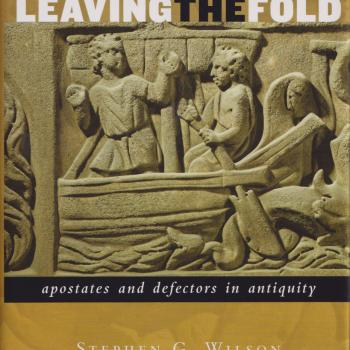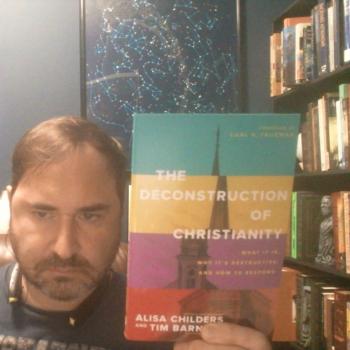
Currently, Cassidy McGillicuddy is a Patheos blogger who writes on the topics of video games, tabletop games, psychology, culture …and the evils of religion. Her blog title nicely sums up these topics by combining the language of gaming with a nod to her atheist stances. The blog is titled “Roll to Disbelieve.”
Love Birds and a New Denomination
Cassidy wasn’t always a godless commentator. She grew up in a devout Catholic home, and in her teenage years, became convinced that Pentecostalism was the way to go. It was in this church environment that she eventually met her husband – a Pentecostal preacher with a silver tongue. Cassidy spent her early adult life in the thrall of his teachings – which, she says, could persuade people of almost anything. She and her husband were married while they she was still in college.
Draining the Pool of Faith
Cassidy describes her Christian faith as being a “faith pool.” Says Cassidy:
“The faith pool is a big pool of reasons to believe. We all have them about whatever we believe …If you encounter something that contradicts your belief and does it in a way you can’t negate somehow, then that debunked reason for belief will drain away. …If the pool is drained too quickly over too short a period of time, though, then faith can’t be poured back into it in time to avoid seeing the true bottom of the pool. Once that happens, I haven’t heard of someone being able to go back to believing. It’s like going back to a belief in Santa Claus, once a child knows why no supernatural sky-wizard is visiting every household in the world in one night. Some contradictions are just too devastating to recover from.”
For Cassidy, the bottom of the pool came in the form of petitionary prayer. Cassidy’s pool began to drain, however, as she came to find things like Creationism and the historical accounts in the Bible to be wildly contrary to the agreed-upon science and history outside of Christian circles. Says Cassidy:
“I’d already encountered–and discarded–belief in literal Creationism. My church officially held that as a doctrine, but even my then-husband Biff and I knew better than to buy into that belief. I knew people believed it, and I was uncomfortable about that belief even as I preached to my various evangelism prospects about the Bible being literally and inerrantly true. I compartmentalized those two beliefs to keep them from jarring, but when I deconverted I had to set them both together for the first time–and saw for the first time how totally crazy it was that I had totally believed both of these two contradictory things.”
When Cassidy found herself asking questions about these things, she was encouraged by her church friends, family, and administers to “just have faith” and the answers would come – which seemed to her more of a dodge than an answer.
Says Cassidy:
“I couldn’t trust the Bible’s history or science, and I couldn’t trust Christianity’s assertions about his power, love, or grace.”
Cassidy tried to maintain her faith on other grounds, however. Says Cassidy:
“See, there are flavors of Christianity that make fewer untrue claims than other flavors do. We’re used to criticizing fundagelicals, who hold the Bible as inerrant and literally true. But most Christians think that attitude is as bizarre, childish, and laughable as we do–even as they hold untrue beliefs themselves that they don’t dare to examine too closely. For that matter, pretty much every religion out there makes some untrue claims about the supernatural and its own ability to help people become better people. Untrue beliefs are just part and parcel of religions generally.”
The Problem of Prayer
At the time of her deconversion, Cassidy was recently out of college, had a respectable marriage to a respected and fervent preacher, as well as a respectable job.
But all was not well. Despite appearances, her marriage was suffering, and beneath her happy life lay angst and turmoil. To address these problems, Cassidy turned to prayer. Her Bible appeared to repeatedly promise that if she brought her prayers to God, he would help her and even provide her heart’s desires.
But as Cassidy got on her knees repeatedly, and discovered that her prayers were going nowhere and being heard by no one, her pool drained completely.
She began to see that the kinds of things she prayed for successfully – safe travel and good parking spots – were banal and as easily gained by accident as by divine intervention. But when her husband and church banned together to pray for healing at a respected member’s deathbed, the answer never came.
In fact, she couldn’t think of a single prayer for supernatural intervention that had ever been obviously answered within her social spheres.
Problems Within Christianity
She saw that even the Bible seemed inconsistent. Earlier books in the New Testament seemed to indicate that Jesus would return within the lifetime of the writers. Later books seemed to make excuses for why that did not come about.
After trying and failing to find reasons to believe, Cassidy said:
“And I rejected it all in one fell swoop. It made no sense, and I was not obligated to keep twisting and contorting my mind to accept all these contradictions and complete fallacies. Nothing held me anymore–there was no fear left in me, and whatever love I’d felt had dissolved over time and with repeated disappointments (something that was happening simultaneously with my “godly” marriage).”
Beyond just simply realizing she had no more reasons to believe, Cassidy was incensed to recognize all of the manipulative and devaluing techniques her husband and the church were using on her in order to keep her in the fold.
Having worked with her husband in Crisis Pregnancy Centers – institutions whose purpose it is to offer care to pregnant women in order to prevent them from having abortions – Cassidy had seen and assisted with counseling techniques she eventually felt were devaluing to the women and manipulatively trying to discourage them from making their own choices. Say’s Cassidy:
“From start to finish, the CPC experience was a packaged and slick presentation of emotional predation, untruths, half-truths, and smoking-hot deception. And they had ensnared my husband, who already had only the most tenuous grasp of human rights and truthfulness. And they had almost ensnared me.”
Once she gained this understanding of the techniques, Cassidy changed her stance from pro-life to pro-choice – a very unpopular position within her church. This change of mind drove tension between her and her husband, as she began to resent the work he did at the CPC.
This, also, drained her belief pool, as she began to feel that the church devalued women in general, and shamed those who didn’t abide by a strict chastity-based system of sexual conduct, even going so far as “victim-blaming.”
The Final Crisis
Her final loss of belief came all at once one night shortly before her husband returned from his work at the Crisis Pregnancy Center. She didn’t talk to him about the crisis, but remained awake all night in anguish. She describes the morning after:
“I felt gaunt and wrung-out. But I also felt a strange exhilaration. I didn’t have to bash my brains out trying to reconcile those things which are not by their nature reconcilable. I no longer had to struggle to understand that which makes no sense whatsoever. Slowly I began to feel strength coursing back into my body as my liberation became more and more clear. I was free. And I would never be enslaved again.”
The morning after this crisis was a Sunday. But she refused to go to church with the exhilarated freedom of knowing she didn’t have to. The pressure of being a pastor’s wife was gone, as she was an adult who made her own choices, controlled her own life, and could not be forced to do anything she didn’t want to. After her husband left for work, she sat down and created her blog “Roll to Disbelieve.” Posting her first entry hours after she had become an atheist.

















